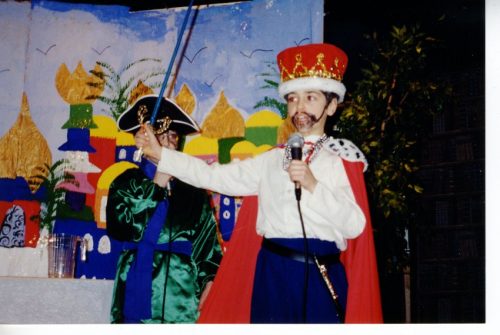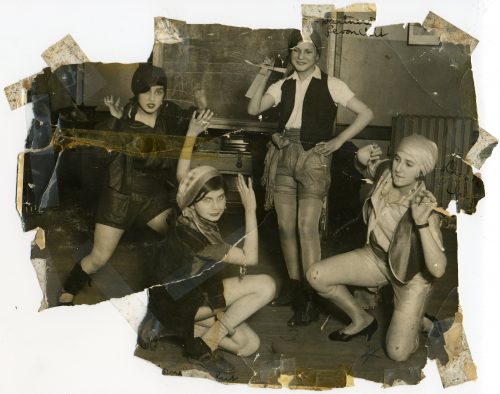Performing Community Part 1

Article by Avi Y. Decter, former JMM executive director, with Erin L. Titter, former JMM archivist. Originally published in Generations – 2003: Entertaining Maryland. To order a print copy of the magazine, see details here.

Part I: Performing Community
On June 1, 2003, 400 community leaders gathered at the Woodholme Country Club for a farewell dinner to honor retiring Associated President Darrell Friedman. The event opened with a musical salute – a medley of songs delivered by The Associated Players, a group of community performers who had provided entertainments for Jewish organizations for thirty years. Accompanied by laughter, cheers, and applause, the Players celebrated Darrell Friedman’s sixteen years at the helm of The Associated. To the tune of “Who Taught Her Everything She Knows,” the Associated Players declaimed:
We hopped aboard and too a lesson from the pro.
You taught us everything.
Going’s now our fav’rite thing.
You are the reason that we glow.
You gave us dignity and pride.
You raised much money on the side.
No matter the task, big or small,
You as our president stood ten feet tall.
And they concluded their performance with a heartfelt rendering of “New York, New York,” telling Mr. Friedman that “Giving your all with love and care/You’re off to help Jews everywhere.”
This Associated Players’ performance is only one recent example in a long tradition of Jewish community performance. Back in 1922, for example, Baltimore Jews crowded Ford’s Theater to take in “The Passing Years,” a dramatized history of Jewish philanthropy from the 1850s to the 1920s written by Louis H. Levin, the executive secretary of the Associated Jewish Charities. The three-act play celebrated the then-new Associated – and the tradition of caring philanthropy within the Baltimore Jewish community.[1]
Performances by The Associated Players – and many other Jewish groups – resonate in varied ways. They express traditional Jewish values such as caring for others, reinforcing a sense of group cohesion and communal purpose. While reflecting a particular moment and circumstance, these performances also promote a course of action for the future, encouraging those assembled to adhere to Jewish ideals and to persist in their identity, philanthropy, and community commitments. In these ways, The Associated Players’ recent appearance is a paradigm of how diverse ethnic, religious, and cultural groups have engaged in “performing community” throughout the last century and more.[2]

Community performances are commonplace, varied, and ephemeral, both within the Jewish community and among other groups. They take place in local schools, congregations, clubs, and agencies, and they appear in many forms – pageants and cantatas, dramas and spiels, musicals, revues, and shows. Some shows emphasize popular entertainment, others focus on moral education, and still others promote cohesion or commitment to a cause. Some are painfully amateurish, others sparkle with professional polish. But whatever their artistic merits and entertainment value, they transmit ideas and identities to and from the community.[3]
Despite their importance, community performances are rarely the subject of serious or sustained attention, except, of course, among the families of those directly engaged in a production. Yet these performances do have meanings: they are heightened moments in the cultural conversations that help to define distinctive communities, episodes in an extended discourse about what it means to be distinctive and American.
Continue to Part II: A Long History
[1] Harry Greenstein, “I Remember…A Jewish Play That Packed Ford’s,” Baltimore Sun, November 18, 1956.
[2] David Glassberg, American Historical Pageantry: The Uses of Tradition in the Early Twentieth Century. (University of North Carolina Press: Chapel Hill, 1990).
[3] Rosemarie K. Bank, Theatre Culture in America, 1825-1860. (Cambridge University Press: New York, 1997), pp. 4-16, 19-22, and passim. See also David Krasner, A Beautiful Pageant: African American Theatre, Drama, and Performance in the Harlem Renaissance, 1910-1927. (Palgrave Macmillan: New York, 2002), p. 1-11 and Tejumola Olaniyan, Scars of Conquest/Masks of Resistance: The Invention of Cultural Identities in African, African-American, and Caribbean Drama. (Oxford University Press: New York, 1995), p. 4 and 139.
